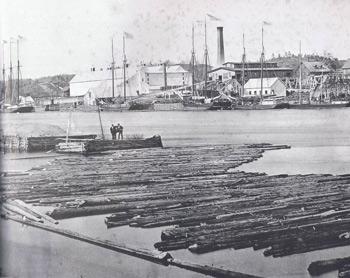B A C K T H E N
Ice House in Pittston

Photo courtesy of Maine Historic Preservation Commission
Perhaps late ’60s. Pittston – now Randolph – north of the present Gardiner-Randolph bridge. Sawmill and icehouse built by Ira D. Sturgis.
The great growth of the ice industry after the Civil War matched a shift in public tastes from salted to fresh meats. Brewers, along with packers, were also major users. Once a luxury, ice became a necessity. Ice which cost thirty cents a ton to harvest on the Kennebec in some years retailed for fifty cents a hundred-weight.
The beginning of the industry dated from the failed 1831 effort by hard-headed Bostonian Frederic Tudor to ship Kennebec ice to the West Indies. By 1850, Tudor and his level-headed superintendent, James Wyeth, working in the Boston area, had solved most of the problems related to the cutting, storing, and shipping of ice. The development of the Kennebec ice industry began with the 1860 arrival of James Cheeseman, the developer of the huge ice industry on the Hudson River and the gainer and loser of a half-dozen fortunes. Cheeseman did well with government contracts during the war, but in 1869, with his affairs in disorder, sold out to Philadelphia’s Knickerbocker Ice Co. About 1872, Great Falls and “the Independent” arrived, followed by Cochran & Oler from Baltimore.
Ira Sturgis of Vassalboro, shipbuilder, lumberman, and farmer, entered the business shortly after Cheesman. In 1865, Sturgis built this icehouse at Pittston, then went to Savannah and Charleston, where he built ice vaults and assembled caravans of red ice carts pulled by mules. He soon forced the local retailers to buy him out and to take contracts for his ice. Haynes & DeWitt, an ice company that Sturgis founded later (noted Augusta businessman J. Manchester Haynes was his son-in-law) early developed markets in Philadelphia and Baltimore.
The economic effect of the ice industry on the Kennebec Valley was enormous. Building icehouses used large quantities of lumber, and the effects on shipbuilding and shipping were also very great. In the boom year of 1890, 1,000 teams and 3,000 men were said to be working on the ice near Gardiner alone. Also attracted was a rag-tag army of poorly dressed tramps, some looking for work, most looking to sponge. Were they came from, and where they went, nobody knew. Note the ropes and rafting wedges tying the logs together.
Text by William H. Bunting from A Day’s Work, A Sampler of Historic Maine Photographs, 1860-1920, Part I. Published by Tilbury House Publishers, Gardiner, Maine, 800-582-1899
